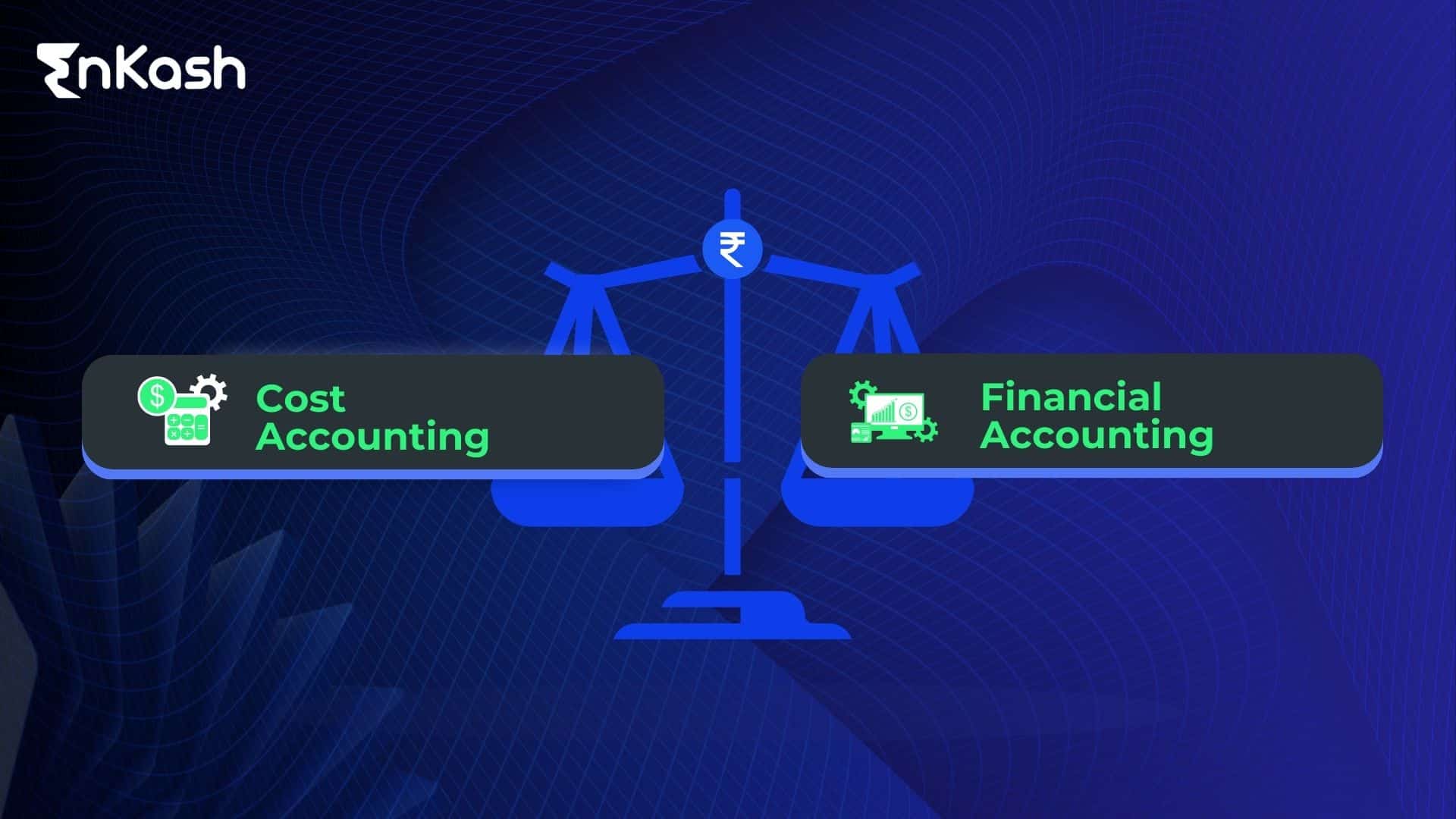Cost Accounting is a major part of business management. Every business owner needs to understand the nuances of accounting to understand the dynamics of their business. Accounting has different types, each of which contributes differently to the financial needs of a business.
Cost accounting helps keep track of the company’s total cost of production. It is done for internal business operations for the management to make informed decisions.
Financial accounting, on the other hand, is undertaken to maintain the business’s financial records, including their daily transactions.
Let us understand the differences between cost accounting and financial accounting in detail.
What is Cost Accounting?
Cost accounting means maintaining and interpreting the total cost of a business’s production.
It focuses on the internal management of business costs and operational budgeting, allowing managers to make decisions based on data that help improve production efficiency and cost-effectiveness.
Businesses can use cost accounting details to optimize their expenses, figure out better pricing strategies, and efficiently allocate budgets and resources.
Users of Cost Accounting Information
The management of the organization uses cost accounting information. Managers use data extracted from cost accounting to make pricing decisions that keep products or services competitive in the market.
Managers also use this data for budgeting, profit analysis, and performance evaluation. Other areas in business like sales targets, cost controls, and strategic planning are also impacted by cost accounting information.
Cost accounting data is invaluable for managers and supervisors, as it provides detailed insights into departmental and project costs. This enables them to make data-driven decisions that improve cost reduction, resource allocation, and efficiency.
The internal stakeholders of the company can use information like the total cost structure of the organization’s products and services to improve the efficiency and profitability of the business.
Key Components of Cost Accounting
Cost Classification
Cost accounting implies the classification of costs into different categories – direct, indirect, fixed, and variable. This classification is further done across different departments for better management.
Monetary Measurement
In cost accounting, all business costs are converted into monetary units for easy comparison.
Future-Oriented
Cost accounting is mainly undertaken to make future decisions based on analyzing business costs.
Strategic Decision-Making
Cost accounting provides detailed cost information that facilitates strategic decision-making for pricing, investment planning, performance evaluation, etc.
Accuracy
Businesses use cost accounting to get precise and accurate cost data that helps them make informed business decisions and control their costs effectively.
Cost Control & Reduction
The cost accounting process helps find areas of inefficiency for cost reduction and optimization.
Benefits of Cost Accounting
Businesses can use cost accounting to optimize their costs and make better decisions for the future. These are the benefits businesses can avail from cost accounting:
Budgeting and Forecasting
Businesses need to have a budget for their operations. Cost accounting enables managers to make an accurate budget and forecast it for the future.
Allocation of Resources
Business managers can allocate resources in different departments based on the data extracted from cost accounting.
Competitive Pricing
Using cost accounting, businesses can understand the cost structure of their products and services in a competitive market.
Performance Evaluation
Cost accounting identifies grey areas that are underperforming and helps in building strategies to improve them.
What is Financial Accounting?
Financial accounting is the process of keeping a record of all business transactions inclusive of sales, purchases, accounts payable, and receivables. This bookkeeping allows businesses to assess their overall financial performance.
These financial transactions are summarized into financial statements like balance sheets, income statements, cash flow statements, and equity statements by shareholders. The main aim of financial accounting is to showcase a business’s profits and losses to stakeholders based on which they can make their decisions.
Types of Financial Statements
There are four types of financial statements:
Balance Sheet
It shows the breakdown of each item owned by the company, including its assets, liabilities, and shareholders’ equity in a specific period. A balance sheet also shows a company’s actual worth by calculating it in a single monetary value.
Income Statement
An income statement exists to showcase the company’s earnings and spending. Also known as a profit and loss statement, it includes revenues, expenses, gains, and losses during a specified period. This statement also helps identify areas needing improvement and allows performance comparisons against competitors.
Cash flow Statement
This statement shows the incoming and outgoing of cash and cash equivalents by a company. It helps analyze a company’s ability to generate cash for debt and operating expenses.
Statement of Retained Earnings
This statement reveals the earnings a company has to invest in its business operations. These earnings are used to pay debts, buy fixed assets, and as working capital. Also known as the statement of owner’s equity, this statement reconciles the earnings from start to end for an accounting period which is further used by analysts to understand the corporate profits.
Key Components of Financial Accounting
Transaction Record: Financial accounting keeps a record of the company’s daily transactions during the fiscal year. It includes transactions related to sales, purchases, investments, expenses, and other miscellaneous financial activities.
Financial Health
A company’s overall financial health and status can be analyzed by looking at its financial accounting statement.
Real-Time Data
The balance sheet of an organization can provide real-time information about a company’s assets, liabilities, and shareholders’ position.
Profit & Loss
Businesses can use income statements to know their revenue, cost, and expenses over a period of time and conclude the profit made and loss incurred.
Cash Resources
The cash flow statement provides information about the cash used and generated across different business activities such as operations, investments, along with how cash resources are managed.
Investment Decisions
The financial information statements can impact decisions like investing in the organization, taxes, regulatory policies, and loans.
Regulatory Compliances
It ensures that financial accounting practices are consistent and transparent, facilitating easier comparisons between companies and industries.
Benefits of Financial Accounting
Financial accounting is the combination of different financial statements that are used across the business. It helps paint the picture of the company’s financial position to the stakeholders involved.
Dependable
Financial accounting works on factual data which cannot be influenced by any external factors. The accounting works on globally accepted accounting principles which makes it trustworthy.
Facilitates Comparison
Financial accounting enables comparison across different timelines within the organization and between different companies despite their size and location.
Basis for Decision Making
Financial statements provide a strong basis for stakeholders in their decision-making process by giving them a detailed view of the financial health of the organization.
Regulatory Compliance
Financial accounting follows compliance with tax laws and other regulatory requirements.
Advantages and Disadvantages of Cost Accounting and Financial Accounting
Advantages of Cost Accounting
Budgeting and Forecasting
Cost accounting is a crucial tool for businesses aiming to develop accurate budgets and forecasts. It facilitates the understanding of how much each operational activity would cost enabling better management of resources and planning effecting expenditure. This makes it easier for such organizations to plan ahead and strategically deploy resources to achieve the set targets in a more efficient manner.
Control of Costs and Cost Reduction
Cost accounting has a wider valued function of indicating where there are cost reduction opportunities. Cost accounting analyzes such factors as Activity Based Costing (ABC) and variance analysis, which assist businesses in finding the trouble spots and excessive costs. It is important for businesses to take a preventive stance on costs, and to know that there are ways to cut or control costs, as these factors are important to survival and success in any market.
Improved Decision Making
Cost accounting allows the management to know the incurred costs for the given products/departments/projects in a more detailed manner. This information is relevant for decisions which are expected to help achieve the goals of the organization. For instance, if the company knows how much each product line costs, it will easily decide on the prices, whether to stop certain products or introduce new ones. Overall, cost accounting encourages efficiency in operations by providing information that management can utilize to improve processes and improve resource allocation.
Disadvantages of Cost Accounting
Difficulty
Building a cost management system can be challenging, as it involves significant data collection and processing related to various costs. This involves careful categorization and allocation of direct, indirect, and overhead expenses. For some organizations, this may present challenges in smooth adoption, because ensuring proper handling cost data can involve having modified personnel and establishment of structure.
Internal Focus
Cost accounting focuses on the needs of the management and other internal stakeholders and so is availed mainly for internal purposes rather than external purposes. Cost accounting does not involve the financial statements drawn by a business towards other outside parties such as investors, creditors, regulators, but internal management only. Therefore, it also does not meet the requirements of external reporting and has no form of imposed structure like what regulatory authorities spend usefulness to the external bodies.
High Implementation Costs
In most instances, developing a cost accounting system that is functional can be very costly. Costs include the need for the business to either buy or lease special cost training software, carry out or customizing the existing reports, as well as training the staff on the necessary modes of capturing the relevant costs. For SMEs, these costs may be too high, as there may be no opportunities for recovery of the setup costs, especially if the business operates with very limited margins.
Advantages of Financial Accounting
Both financial and cost accounting play critical roles in managing a company’s finances, but they serve different purposes and offer distinct advantages and disadvantages
Dependability and Uniformity
One of the advantages of financial accounting is that it is a consistent representation of the entity’s economic status since it is verifiable and standardized. Every framework such as GAAP or IFRS has its own specific rules to follow and this brings in uniformity in financial statements. This adherence to structured standards ensures consistency across financial statements, enabling stakeholders to rely on the information presented to assess a company’s performance and financial stability accurately.
Facilitates Comparison
With the use of financial statements a corporation can assess its business activities over various periods or with other organizations operating in the same industry. Such demographic analysis makes it possible to get some insights, such as which way to look for more revenue or how much increase in revenues is realistic in the short term and what are the competitive challenges expected. In this way financial information is more precise, thus making it possible to implement control within an organization and carry out effective business planning.
Regulatory Compliance
The need for financial accounting is more pronounced as this simply ensures that all business activities comply with local and global laws. Due to obeying the set rules, it becomes easy to promote financial reporting and compliance which attracts investors and creditors and even regulators. Effective reporting and compliance help the organizations avoid the law and also show respect of the law which helps in building and maintaining their image as well as keeping their operations intact
Disadvantages of Financial Accounting
Historical Data Focus
Financial accounting classes of transactions and events and this has more to evaluate, which in this case creates a problem in deviating a certain trend or opportunity in business. In addition, since it studies past efforts in most of its segments, financial accounting does not adequately prepare management to take calculated business risks. Therefore, chargeable accounting only may prevent progressive management from most challenges and opportunities for the common good for the organization
Rigid Standards and Regulations
Financial accounting should settle with certain conventions, for example, GAAP or IFRS, which have been found to restrict how free one can be in presenting usable financial information. These usually assist in maintaining both uniformity and precision on the prepared figures but might distort the managerial intentions of adjusting the figures for internal purposes. Such inflexibility may be a problem, especially when management needs special information for its operations, since financial accounting is not designed to deliver such internal structuring of data.
Insufficient Operational Understanding
Financial accounting helps understand the monetary level of the organization, yet it includes detailed information of operation’s activities within the organization. Financial accounting is less detailed than cost accounting, which disaggregates expenses and analyzes efficiency for different lines of business. Therefore, it might not be suitable for the users with respect to the level of insight needed in operating activities within a day such as monitoring expenses on various aspects or the level of control of the expenses.
Difference between cost and financial accounting
These are the key differences between cost and financial accounting.
Motive
The primary role of cost accounting is to provide data to internal stakeholders of the organization like managers and employees to make better operational and strategic planning decisions.
Financial accounting, on the other hand, provides financial information to external parties like investors, regulators, and lenders to know the financial health of the organization and make decisions based on data.
Regulatory Bodies
Cost accounting doesn’t have any specific rules or standards to follow. The process may vary depending on the company as per their internal requirements.
Financial accounting, however, is governed by Generally Accepted Accounting Principles (GAAP) or International Financial Reporting Standards (IFRS).
Range
Cost accounting is limited to individual activities or processes in the organization. It analyzes the cost of products, departments, or projects.
Financial accounting has a wider range with multiple statements involved. It looks at the company as a whole entity and functions accordingly. It provides an overall picture of the financial health of the entire business based on data from different statements.
Frequency
Cost accounting is done on a daily, weekly, or monthly basis to provide regular data for better management decisions.
On the other hand, financial accounting is undertaken quarterly or annually.
Reporting
Cost accounting reports are for internal purposes only and are confidential. These reports are meant to be used by the company’s management.
Financial accounting reports are mandatory to be publicly reported as external stakeholders are involved.
Both financial and cost accounting are crucial for businesses to make important decisions. Each of these accounting types contributes differently to business making them equally important.
Difference Between Modern Trends in Cost Accounting and Modern Trends in Financial Accounting
Aspect |
Modern Trends in Cost Accounting |
Modern Trends in Financial Accounting |
Purpose |
Deals primarily with the costs incurred within the organization to help with the budget and making operational decisions |
Provides financial information for outside parties, focusing on overall financial health. |
Primary Users |
Primarily managers and internal users for decision-making |
Investors, creditors, regulators, and external stakeholders |
Reporting Frequency |
Frequent reporting (daily, weekly, monthly) |
Generally occurs every three or twelve months |
Regulatory Requirements |
There are no rigid governing standards. |
Must follow GAAP or IFRS for uniformity and jurisdiction |
Flexibility |
Highly flexible, adapted to specific company needs |
Rigid and standardized for comparability across industries |
Decision Support |
Supports immediate, operational decision-making |
Helpful for making long-term investments and other strategic plans |
Technological Integration |
Uses AI for automation and predictive cost analysis |
Uses blockchain for better transparency and uses machine learning in ensuring that audits are carried out |
Challenges with Financial and Cost Accounting
Challenges in Financial Accounting
Financial accounting faces a range of complex challenges as it adapts to a dynamic business landscape. This section explores key obstacles that professionals encounter in the field, focusing on the impact of regulatory changes, the imperative for accuracy, and the integration of new technologies
Changing Regulatory Environment
Financial accounting is a constantly evolving field due to regular updates to accounting standards, tax legislation, and other regulations. These standards can be quite changing and thus, the organization has to make sure its accounting practices are in line with the current limits. This implies that in most cases the accounting department may require regular refreshers. There might be a need to modify the organization’s internal processes. Accepting and adhering to the new rules is an important step and prevents losses and troublesome situations from occurring.
Ensuring Accuracy and Reliability
It is essential in financial accounting that financial claims concerning a client’s finances are precise in every aspect because any mistakes can have dire consequences. Due to the complexity caused by modern business negotiations involving numerous data and large transactions ensuring 100% correctness is hardly possible. Even the smallest typos and mistakes present in figures in the financial statements can result in distortion of the true picture of the company’s finances which cuts across investing prudently, lawfully, and making sound decisions. Furthermore, finding and fixing mistakes is labor intensive and meticulous to prevent wrong reporting.
Integrating New Technologies
To enhance their effectiveness and precision, many organizations are already introducing modern accounting information systems, artificial intelligence, and automation. Nonetheless, the incorporation of these technologies may prove difficult, especially for companies that are used to the old-fashioned ways of doing things. Equipping personnel with skills to work with complex systems as well as changing the way business functions to include new systems takes a great deal of time and money. Moreover, the organizations may have challenges implementing full digital uptake of solutions, about the normal running of the operations.
Challenges in Cost Accounting
Cost accounting plays a crucial role in helping organizations manage and control their expenses, but it also comes with its own set of challenges. This section examines key difficulties that professionals face in ensuring accuracy and relevance in cost accounting, focusing on data collection, cost allocation, and the need for constant updates.
Data Collection and Precision
Cost accounting is dependent on the accurate integration of data from different departments such as production, goods procurement, sales, and so on. In the case of big firms or those that mass produce goods, collecting such data in real-time may prove unfeasible. This is because improper or poor data integration affects the analysis of cost, which ultimately is used in budgeting and even financial planning. Thus, this challenge requires an efficient data system to monitor cost changes while maintaining data accuracy, especially in industries with highly volatile costs.
Complexity in Cost Allocation
The allocation of indirect costs such as administrative costs, utility costs, and other overheads is not only cost accounting but an important factor as far as cost accounting is concerned. The principles of ABC help in assigning those secondary costs to products or services that occupy the resources. But following these principles is not so easy as there is a need to properly decide on which costs for what activities should be assigned to which products or services and in what proportion. If costs are allocated incorrectly, it will lead to the wrong pricing strategy which will compromise profitability and market competitiveness.
Need for Constant Updates
Cost accounting entails amending of previous cost accounting data judiciously to make provision for changes in the production cost of units, raw materials, and labor among other costs. Such amending of cost data regularly is tiresome as it is often expected that the cost data is in line with the operations of the business on a day-to-day basis. In such industries like textiles where production levels alter often, or where the cost of raw materials varies greatly, it becomes necessary to change cost data more frequently which is however a lengthy process.
FAQs
What is cost accounting?
A type of accounting process that calculates a company’s total cost of production by assessing the variable costs as well as fixed costs. It aims to report, analyze, and control internal costs.
What is financial accounting?
A branch of accounting that focuses on the preparation of financial statements for external stakeholders such as investors, creditors, and regulatory bodies. It is undertaken by following certain specific standards (like GAAP or IFRS) to ensure consistency.
Does cost accounting impact financial accounting?
Cost accounting can impact financial accounting as data collected and analyzed through cost accounting can provide valuable insights for financial accounting, like inventory valuation, cost of goods sold, and budget preparation.
What is the role of cost accounting in decision-making?
Cost accounting helps identify cost-saving opportunities, optimize resource allocation, define competitive pricing, and enhance overall operational efficiency.
What is the role of financial accounting in decision-making?
Financial accounting provides a clear view of the company’s financial health helping stakeholders assess the performance and make decisions accordingly.








